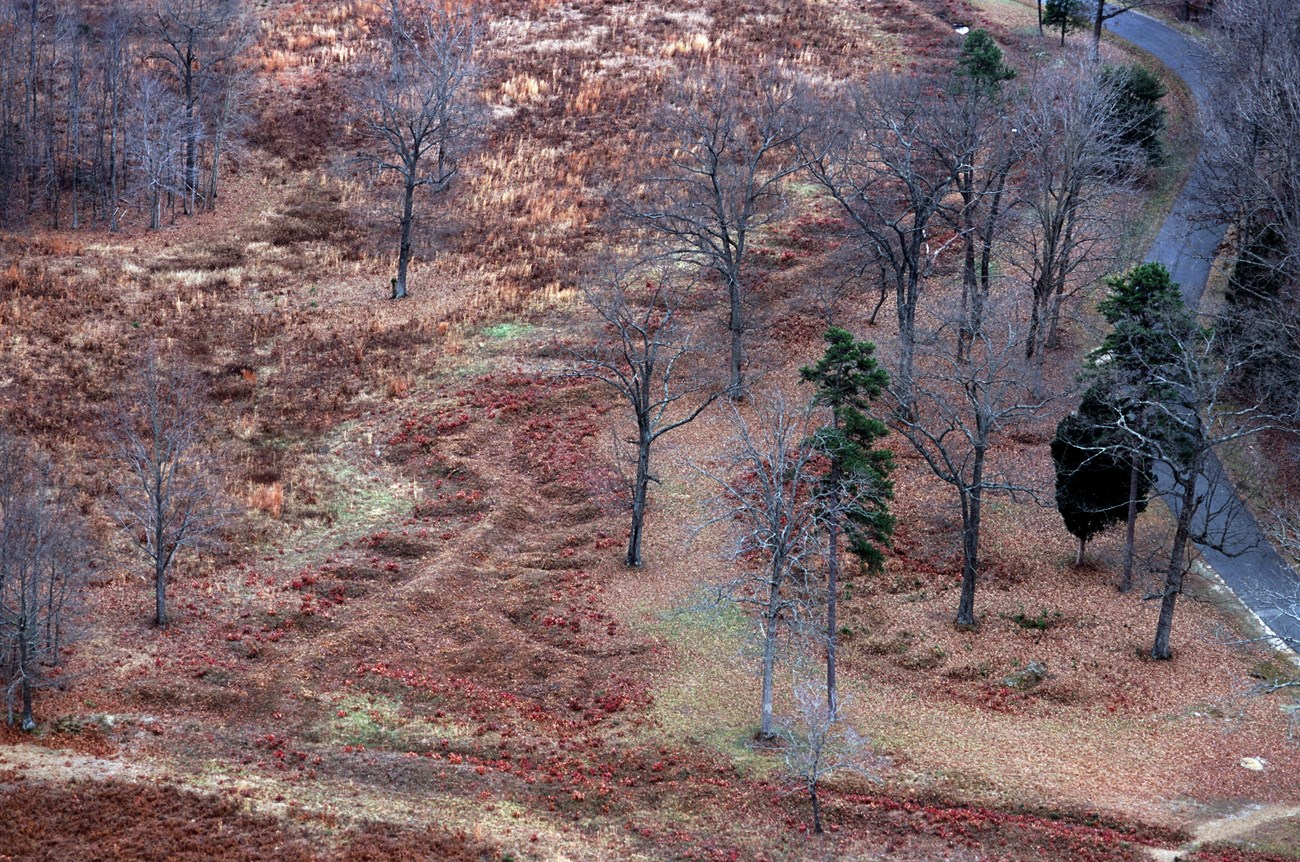Last updated: May 15, 2025
Article
1929 Churchill Visit to Virginia Battlefields
Future Prime Minister Winston Churchill Visits the Fredericksburg-Area Battlefields and the New National Military Park, 1929
In 2023, Fredericksburg and Spotsylvania NMP Park Historian Noel Harrison came across the attached link to the Imperial War Museum’s recent, public posting of a film made in 1929 by Maj. John Churchill, brother of British statesman and future prime minister Winston Churchill. Its footage between minutes 5:24 and 6:44 documented their visits to the Sunken Road and Stone Wall, Brompton (the “Marye House” of the Civil War-era), the Fredericksburg National Cemetery, Spotsylvania, and Chancellorsville. [1] We share the link to coincide with the 60th anniversary of Churchill’s death.
On October 20, 1929, the Churchill brothers and party arrived by automobile at Fredericksburg, lunched at the Princess Anne Hotel, toured area Civil War sites in the order listed above—visits to the monument to Bvt. Maj. Gen. Alexander Hays in the Wilderness, and to Salem Church occurring on either side of their Chancellorsville stop but evidently not filmed—then departed for Washington. Fredericksburg attorney and former state legislator C. O’Conor Goolrick acted as their host and general guide for the Fredericksburg area battlefields, Spotsylvania businessman George W. Perry as their guide for the Mule Shoe and Bloody Angle specifically. [2]
In 2023, Fredericksburg and Spotsylvania NMP Park Historian Noel Harrison came across the attached link to the Imperial War Museum’s recent, public posting of a film made in 1929 by Maj. John Churchill, brother of British statesman and future prime minister Winston Churchill. Its footage between minutes 5:24 and 6:44 documented their visits to the Sunken Road and Stone Wall, Brompton (the “Marye House” of the Civil War-era), the Fredericksburg National Cemetery, Spotsylvania, and Chancellorsville. [1] We share the link to coincide with the 60th anniversary of Churchill’s death.
On October 20, 1929, the Churchill brothers and party arrived by automobile at Fredericksburg, lunched at the Princess Anne Hotel, toured area Civil War sites in the order listed above—visits to the monument to Bvt. Maj. Gen. Alexander Hays in the Wilderness, and to Salem Church occurring on either side of their Chancellorsville stop but evidently not filmed—then departed for Washington. Fredericksburg attorney and former state legislator C. O’Conor Goolrick acted as their host and general guide for the Fredericksburg area battlefields, Spotsylvania businessman George W. Perry as their guide for the Mule Shoe and Bloody Angle specifically. [2]

NPS Photo
He perhaps bore in mind Maj. Gen. Ulysses S. Grant’s May 11, 1864 message to U. S. Secretary of War Edwin M. Stanton, proposing “to fight it out on this line if it takes all summer” and delivery on that pledge to Stanton with the very next day’s attack on the Confederate-held fortifications at the Bloody Angle and other areas along the Mule Shoe and at Spotsylvania. Churchill’s 1929 article continued, “Destiny pivoting here has stamped the ground with a ruthless heel; the path of the world takes a different turn henceforward.” (Although the article did not quote Grant’s message to Halleck, Churchill would quote it in a historical work that he published in the 1950’s.) [4]
For nearly a week before the message to Halleck, however, Grant was already fighting ”it out” on what became famed as the Overland Campaign route. Churchill’s placement in 1929 of Destiny’s pivot at the Bloody Angle rather than at, say, the Brock Road-Plank Road intersection on the Wilderness Battlefield and with Grant’s personal turn southward there on May 7, 1864, is noteworthy as historical interpretation. Perhaps the itinerary of the 1929 tour, with the visit to Spotsylvania coming before Wilderness, and Churchill’s extended, tactile immersion in the landscape and artifacts of the former, influenced the same emphasis in his Daily Telegraph article. The 1929 article found international circulation not only though reprints in many newspapers in 1930 but in later books by and about Churchill.
In the Fredericksburg-area sequences of the 1929 film, he appears most clearly, in profile at the 5:28 mark, while standing on the lower lawn of Brompton bordering the stone wall at Sunken Road and Hanover Street. Beyond depicting a personage of his already considerable fame, the film offers some of the earliest known, if not the earliest, motion picture footage of the new battlefield park and adjoining, non-park battlefield properties. Footage of some of the Seven Days battlefields precedes the Fredericksburg-area sequences. Footage of Gettysburg follows.
https://www.iwm.org.uk/collections/item/object/1060036146
Sources
[1] THE VISIT OF MAJOR JOHN CHURCHILL WITH HIS BROTHER WINSTON CHURCHILL TO THE USA IN 1929 [Allocated Title], Imperial War Museum, MGH 5194, at https://www.iwm.org.uk/collections/item/object/1060036146
[2] ‘’VIRGINIA FEARS PRICE OF PROGRESS SAYS STATESMAN,’’ The Free Lance-Star (Fredericksburg), Jan. 9, 1930; ‘’WINST’N CHURCILL PAYS VISIT HERE,’’ The Free Lance-Star (Fredericksburg), Oct. 21, 1929.
[3] Winston S. Churchill, ‘’OLD BATTLEFIELDS OF VIRGINIA,’’ The Daily Telegraph (London), Dec. 16, 1929, in Sir Winston Churchill, The Great Republic: A Short History of America, 1999, p. 244 (quotations).
[4] ________________, The Great Republic: A Short History of America, pp. vi (list of Churchill’s historical publications in 1950’s), 211 (first quotation), 244 (second quotation).
Tags
- fredericksburg & spotsylvania national military park
- gettysburg national military park
- national mall and memorial parks
- richmond national battlefield park
- statue of liberty national monument
- the white house and president's park
- videos
- historic video
- fredericksburg national cemetery
- sunken road
- chancellorsville battlefield
- fredericksburg battlefield
- spotsylvania battlefield
- national park history

